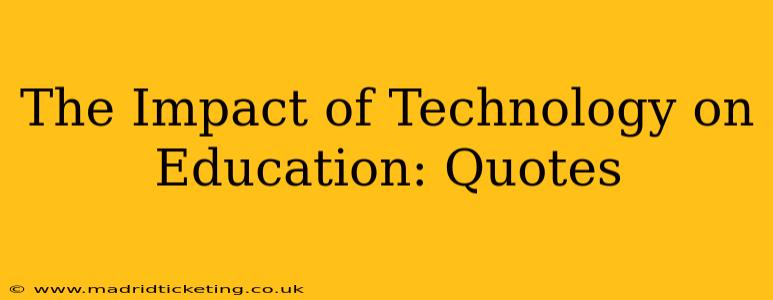The Impact of Technology on Education: Quotes and a Deeper Dive
Technology's influence on education is undeniable, revolutionizing how we teach and learn. From interactive whiteboards to AI-powered tutoring systems, the digital age has reshaped the educational landscape. This article explores this impact through insightful quotes and a comprehensive analysis, addressing some of the most frequently asked questions surrounding this transformative shift.
Introduction:
The integration of technology in education is a double-edged sword. While offering incredible opportunities for personalized learning, increased access to information, and enhanced engagement, it also presents challenges related to digital divides, data privacy, and the potential for over-reliance on technology. Understanding both the benefits and drawbacks is crucial for harnessing technology's potential effectively.
Key Quotes that Highlight the Impact of Technology in Education:
-
"Technology is just a tool. In terms of getting the kids working together and motivating them, the teacher is the most important." – Bill Gates: This quote highlights the crucial role of educators even in a technologically advanced learning environment. Technology facilitates learning, but the teacher remains the guiding force.
-
"The purpose of education is to transform the mirror of society into a window to the future." – John H. Gaddis: While this quote doesn't directly mention technology, it emphasizes education's role in shaping the future. Technology serves as a powerful tool to achieve this transformation by providing access to global perspectives and future-oriented skills.
Frequently Asked Questions (FAQs):
1. How has technology improved access to education?
Technology has dramatically expanded access to education, particularly for students in remote areas or those with disabilities. Online learning platforms, digital textbooks, and virtual classrooms transcend geographical limitations, providing educational opportunities to individuals who might otherwise be excluded. For example, the Khan Academy offers free online courses covering a wide range of subjects, accessible globally. Assistive technologies like screen readers and speech-to-text software empower students with disabilities to participate fully in the learning process.
2. What are the benefits of using technology in the classroom?
Classroom technology offers several benefits:
- Enhanced Engagement: Interactive simulations, educational games, and multimedia content can significantly enhance student engagement and make learning more enjoyable.
- Personalized Learning: Technology allows for tailored learning experiences catering to individual student needs and learning styles. Adaptive learning platforms adjust the difficulty level based on student performance, ensuring optimal learning pace.
- Improved Collaboration: Online platforms facilitate collaboration among students, fostering teamwork and communication skills.
- Increased Accessibility: Assistive technologies and online resources remove barriers for students with disabilities, ensuring inclusivity.
- Development of 21st-Century Skills: Technology integration helps students develop essential skills like digital literacy, critical thinking, problem-solving, and creativity, crucial for success in the modern world.
3. What are the challenges of using technology in education?
Despite its advantages, technology integration presents challenges:
- The Digital Divide: Unequal access to technology and reliable internet connectivity creates a digital divide, excluding students from disadvantaged backgrounds.
- Cost and Maintenance: Implementing and maintaining technology infrastructure can be expensive, placing a strain on school budgets.
- Teacher Training: Educators require adequate training and support to effectively integrate technology into their teaching methods.
- Data Privacy and Security: Concerns about student data privacy and the security of online learning platforms need to be addressed.
- Distraction and Misuse: Students may misuse technology for non-educational purposes, leading to distractions and hindering learning.
- Over-reliance on Technology: A balanced approach is crucial; over-dependence on technology can hinder the development of essential skills like critical thinking and problem-solving.
4. What are some examples of effective technology use in education?
Effective examples include:
- Interactive Whiteboards: Enhancing engagement and collaboration through interactive lessons.
- Learning Management Systems (LMS): Centralized platforms for course materials, assignments, and communication.
- Educational Apps and Software: Providing engaging and personalized learning experiences.
- Virtual Reality (VR) and Augmented Reality (AR): Immersive learning experiences that bring subjects to life.
- AI-powered Tutoring Systems: Providing personalized feedback and support to students.
Conclusion:
Technology's influence on education is profound and multifaceted. While challenges exist, the potential benefits are immense. By thoughtfully integrating technology, addressing the digital divide, and providing adequate teacher training, we can harness technology's power to create more engaging, accessible, and effective learning experiences for all students. The future of education is inextricably linked to technology, and navigating this evolving landscape effectively is crucial for shaping a brighter future for learners everywhere.

